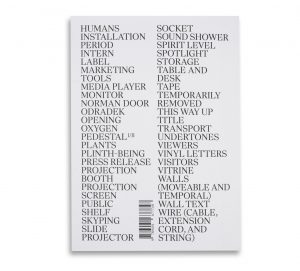Niekolaas Johannes Lekkerkerk: The Standard Book of Noun-Verb Exhibition Grammar (2018)

The Standard Book of Noun-Verb Exhibition Grammar is a partial compendium of the different modes of being that inhabit exhibitions. These different modes of being, often placed outside the realm of art objects proper, are described and activated here as crucial players in the world of contemporary art.
 Maximizing a poetic resourcefulness, this book proposes the exhibition as an ecology full of things that are infinitely more dimensional than their ascribed functionality would lead us to believe, and creates a space where species meet, where ontological and epistemological registers clash, overlap, and contaminate each other, where the living and inert, organic and inorganic exchange properties, qualities, and performances.
Maximizing a poetic resourcefulness, this book proposes the exhibition as an ecology full of things that are infinitely more dimensional than their ascribed functionality would lead us to believe, and creates a space where species meet, where ontological and epistemological registers clash, overlap, and contaminate each other, where the living and inert, organic and inorganic exchange properties, qualities, and performances.
Ultimately this book aims to show that what revolves around, within, and beyond any given system, resolves to be just as serious and important as what that system aims to convey.
Niekolaas Johannes Lekkerkerk: The Office For Curating
Onomatopee








